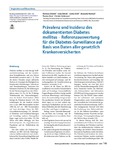Prävalenz und Inzidenz des dokumentierten Diabetes mellitus – Referenzauswertung für die Diabetes-Surveillance auf Basis von Daten aller gesetzlich Krankenversicherten
Schmidt, Christian
Reitzle, Lukas
Dreß, Jochen
Rommel, Alexander
Ziese, Thomas
Heidemann, Christin
Hintergrund:
Prävalenz und Inzidenz des dokumentierten Diabetes sind wesentliche Kennzahlen, für die im Rahmen der Nationalen Diabetes-Surveillance eine wiederkehrende Ermittlung geplant ist.
Methodik:
Es wurden Daten nach der Datentransparenzverordnung ausgewertet, die ambulante und stationäre Versorgungsinformationen zu allen rund 70 Mio. gesetzlich Krankenversicherten enthalten. Die Falldefinition für die Prävalenz des dokumentierten Diabetes umfasst eine in mindestens zwei Quartalen eines Jahres vorliegende gesicherte ambulante Diagnose oder eine in mindestens einem Quartal eines Jahres vorliegende stationäre Diagnose gemäß ICD-10-Codes E10.- bis E14.-. Die Inzidenz wurde auf Grundlage derselben Definition und mit einem Jahr diagnosefreier Vorlaufzeit berechnet.
Ergebnisse:
Im Jahr 2011 ist für gesetzlich Versicherte eine Prävalenz von 9,7 % (Frauen: 9,4 %, Männer: 10,1 %) beobachtbar. Es existieren Prävalenzunterschiede zwischen den Bundesländern, wobei der maximale Unterschied 7,1 %-Punkte (altersstandardisiert: 4,0 %-Punkte) beträgt. Typ-2- und Typ-1-Diabetes zeigen eine Prävalenz von 7,5 % bzw. 0,28 %. Ein unspezifischer Diabetes wird mit 1,9 % relativ häufig dokumentiert. Bei 0,21 % der Personen wird der Diabetes ausschließlich über eine stationäre Nebendiagnose dokumentiert. Zusätzlich weisen 0,17 % der Personen ohne dokumentierten Diabetes mindestens eine Verordnung eines Antidiabetikums auf. Im Jahr 2012 sind 565.040 Versicherte neu an Diabetes erkrankt, dies entspricht 1,0 % der Versicherten (Frauen: 1,0 %, Männer: 1,1 %).
Diskussion:
Die erarbeitete Referenzauswertung ist für die Berichterstattung von Prävalenz und Inzidenz des dokumentierten Diabetes im Rahmen der Diabetes-Surveillance geeignet. Die Unterscheidung der Diabetestypen ist aufgrund der Codierungspraxis schwierig. Background: The prevalence and incidence of documented diabetes are two essential indicators intended to be reported on a periodic basis within the framework of diabetes surveillance in Germany.
Methodology:
Data provided based on the Data Transparency Act were analyzed. The data contain information on outpatient and inpatient care for all approximately 70 million persons with statutory health insurance. The case definition for the prevalence of documented diabetes comprises a confirmed outpatient diagnosis in at least two quarters of a year or an inpatient diagnosis in at least one quarter of a year in accordance with ICD-10 codes E10.- to E14.-. The incidence was calculated based on the same definition and with one year of diagnosis-free lead time.
Results:
In 2011, a prevalence of 9.7% (women: 9.4%, men: 10.1%) was observed for persons with statutory health insurance. There are considerable differences in prevalence between the federal states and the maximum gap is 7.1 percentage points (age standardized: 4.0 percentage points). Type 2 and type 1 diabetes show a documented prevalence of 7.5% and 0.28%, respectively. Unspecified diabetes is documented relatively frequently with 1.9%. In 0.21% of persons, the diagnosis diabetes is documented via one inpatient secondary diagnosis. In addition, 0.17% of people without documented diabetes have at least one prescription of an antidiabetic drug. In 2012, 565,040 insured persons were newly diagnosed with diabetes; this corresponds to 1.0% of the insured persons (women: 1.0%, men: 1.1%).
Discussion:
The developed reference analysis is suitable for reporting the prevalence and incidence of documented diabetes within the framework of diabetes surveillance. The differentiation of diabetes types is difficult due to coding practice.
Dateien zu dieser Publikation
Keine Lizenzangabe
Verwandte Publikationen
Anzeige der Publikationen mit ähnlichem Titel, Autor, Urheber und Thema.
-
2019-06-19ZeitschriftenartikelTypes of diabetes are not limited to age groups: type 1 diabetes in adults and type 2 diabetes in children and adolescents Rosenbauer, Joachim; Neu, Andreas; Rothe, Ulrike; Seufert, Jochen; Holl, Reinhard W.Based on data from the national diabetes registry DPV (Diabetes patient documentation), the diabetes registry of North Rhine-Westphalia and surveys conducted at hospitals and practices in Baden-Württemberg and Saxony, ...
-
2017-05-03ZeitschriftenartikelLongitudinal change in health-related quality of life in people with prevalent and incident type 2 diabetes compared to diabetes-free controls Schunk, Michaela; Reitmeir, Peter; Rückert-Eheberg, Ina-Maria; Tamayo, Teresa; Schipf, Sabine; Meisinger, Christa; Peters, Annette; Scheidt-Nave, Christa; Ellert, Ute; Hartwig, Saskia; Kluttig, Alexander; Völzke, Henry; Holle, RolfObjective: The objective of this analysis is to compare people with prevalent type 2 diabetes, incident type 2 diabetes and without diabetes with respect to longitudinal change in health-related quality of life (HRQOL) ...
-
2012-05-13MasterarbeitEvaluation of the German Diabetes Risk Score as a screening tool for undiagnosed diabetes Paprott, RebeccaBackground: Regional German studies estimated the prevalence of undiagnosed diabetes to be almost as high as the prevalence of diagnosed diabetes. Even before symptoms of diabetes occur, diabetes related secondary diseases ...

